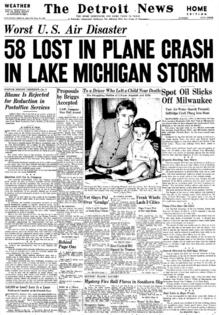Searchers end quest to find airliner that went missing over Lake Michigan 75 years ago
Published in News & Features
DETROIT — Researchers have ended a 20-year quest to find the wreckage of a 1950 airliner that disappeared over Lake Michigan in what was then the worst aviation disaster in U.S. history.
While the demise of Northwest Orient Flight 2501 remains a mystery, the research efforts have yielded additional clues to the crash that claimed 58 lives in the early morning hours of June 24, 1950, including the prevailing theory of what occurred in its last moments.
The Holland-based Michigan Shipwreck Research Association will not search for the wreckage this year, said Valerie van Heest, the executive director. Her organization has searched each year since 2004.
"It's a hard thing to have to say because part of me feels like we have failed, but we have done so much to keep memory of this accident and these victims at forefront that I feel like we've done better for them than if we'd found the wreckage," van Heest told The Detroit News.
Van Heest wrote "Fatal Crossing: The Mysterious Disappearance of NWA Flight 2501 and the Quest for Answers" and created a traveling museum exhibit. Her efforts, and those of her group, attracted the interest of author Clive Cussler. They also discovered and memorialized two unmarked mass graves and cemented a theory of the crash that might be as close as anyone will come to deciphering what happened.
Northwest Orient Flight 2501, a four-engine propeller-driven DC-4, left New York's LaGuardia Airport the evening of June 23 bound for Seattle with planned stops in Minneapolis and Spokane, Washington. It was last heard from when its pilot requested clearance to drop from 3,500 feet to 2,500 feet as it attempted to navigate through a violent approaching storm. The clearance was denied because of nearby air traffic.
When the plane did not respond to radio requests and did not pass near Milwaukee's Mitchell Field at its appointed time, it was presumed lost and a search ensued. An oil slick and debris were found, but no survivors.
South Haven's South Beach closed for nine days as body parts and debris washed ashore. The investigation that followed did not determine a cause.
Van Heest's organization. which was focused on finding Great Lakes shipwrecks, initially had little interest in the lost fatal flight.
"We just wanted to be aware of this in case we ran into aircraft debris," she said. "But what really intrigued me is we got some press in 2004 when we did an article about (the flight), and Clive Cussler saw that article. He offered to send his team down, and you just don't turn down Clive Cussler, one of the world's most famous wreck hunters."
Families of the deceased also began reaching out to van Heest, furthering her interest.
Cussler, an author of more than 80 books and founder of the National Underwater Marine Agency, funded years of searches for Flight 2501, at an estimated cost of more than $500,000.
"Starting in 2004, I helped try for several years to find the wreckage," Cussler wrote on social media on the anniversary of the crash in 2018. "Others have continued to search, and I hope someday the families of those lost will have closure."
Cussler ended funding in 2017 and died in 2020 at age 88.
Families of the victims also reached out to van Heest, which furthered her interest in the search.
She and her group continued for another seven years. In all, 700 square miles of Lake Michigan lakebed were searched with side-scanning sonar at lake depths of 100 to 350 feet. Researchers enlisted the assistance of scientists who study weather and lake currents to create a new picture of the violent storm and the likely radius of the crash based on the debris field, but no aircraft wreckage was ever found.
"Our conclusion, after covering 700 square miles and double covering 50 or so that the scientists had narrowed it down to came to (the) conclusion that the debris was too broken up" to appear on sonar, van Heest said. "We believe, with the lake bottom being what it is, (it) had sunk into the muck."
In addition to developing a theory on the crash, they helped uncover where the remains collected by the U.S. Coast Guard and beachcombers were buried.
"We started combing the records of local cemeteries," she said. "(St. Joseph) Riverview Cemetery had a notation that it had donated a mass grave, and we found out that remains had been cremated, but there was no marker. We thought that was so disrespectful."
In 2008, the Filbrandt Family Funeral Home donated a granite marker for the gravesite with the notation "In Memory of Northwest Flight 2501" and listing the names of the lost and the words, "Gone But Never Forgotten," and family members of victims attended a ceremony there. Seven years later, a second previously unmarked gravesite was found at Lakeview Cemetery in South Haven and a stone marker was placed there in 2015.
For van Heest, her quest turned had turned into seeking closure for the families of victims, who had never gotten answers.
"I had heartbreaking conversations with seniors who would cry over phone talking about this, so it was still so raw," she said. "My interest was a feeling of responsibility of bringing closure to the families and I feel like I've done it with book the exhibit and knowing details that they didn't have in 1950."
So what happened to Northwest Orient Flight 2501?
"With all of our research and by connecting with Northwest personnel, we came up with information never publicly shared," van Heest said, about storm information that was not communicated to the pilots. "So we feel quite confident the plane entered the stormfront unaware (that) the storm front had shifted south. We feel quite confident that a downdraft, also called microburst, hit the plane. And we say that based on the debris that came ashore and that the Coast Guard collected ... we know this plane hit the water with great force, and we know there was no way to survive this."
_____
©2025 The Detroit News. Visit detroitnews.com. Distributed by Tribune Content Agency, LLC.







Comments